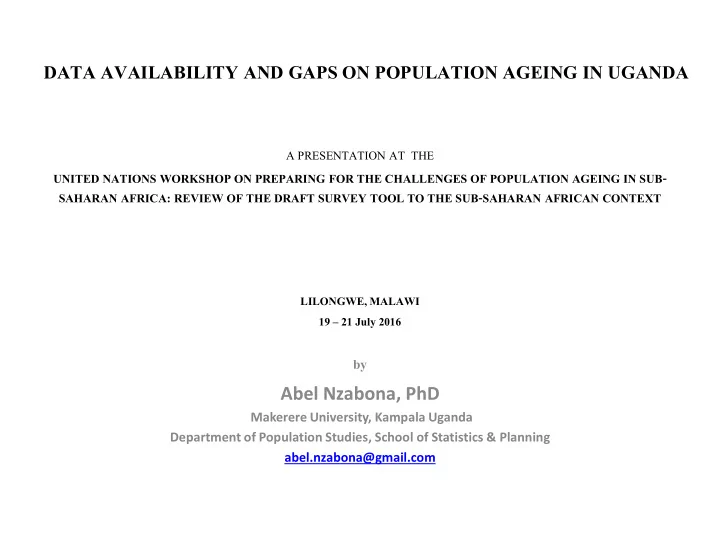

DATA AVAILABILITY AND GAPS ON POPULATION AGEING IN UGANDA A PRESENTATION AT THE UNITED NATIONS WORKSHOP ON PREPARING FOR THE CHALLENGES OF POPULATION AGEING IN SUB- SAHARAN AFRICA: REVIEW OF THE DRAFT SURVEY TOOL TO THE SUB-SAHARAN AFRICAN CONTEXT LILONGWE, MALAWI 19 – 21 July 2016 by Abel Nzabona, PhD Makerere University, Kampala Uganda Department of Population Studies, School of Statistics & Planning abel.nzabona@gmail.com
Outline of the presentation 1. Introduction 2. Study Methodology 3. Summary of findings 4. Conclusions/Recommendations 2
Introduction • Uganda is one of the EA countries with rising number of older persons. • Number tripled from just under 0.5m in 1969 to about 1.5m in 2014. • Represents 4.1% of the 34.6m of 2014 country population (UBOS, 2016). • Trend calls for better understanding of situation of older persons.
Study Methodology • A data assessment study was done (25 th Jan - 30 th May 2016) • Key sources of information were: – Documents (Policy, legal & regulatory documents) – Data collection tools (Census & Survey questionnaires, HMIS reporting schedule) – Electronic Journal Databases ( ELSEVIER, AFRAN, APHRC, HINARI, AGORA, BIOMED CENTRAL, PUBMED CENTRAL & GOOGLESCHOLAR – NSO, Ministries & Academia 4
Summary of Findings A. Available data • Basic data obtained mainly from household module of NPHC, NHS, DHS & NCDS questionnaire. (i) Demographic characteristics • Number of older persons by Age, Sex, residence, Marital status (ii) Socioeconomic characteristics • Number of older persons by School attendance, Literacy, Education, Religion, Employment, Occupation (iii) Health characteristics • Reported info on disability & Selected NCDs (diabetes, HT) • Likelihood of underreporting or misreporting. • Hardly any data that directly brings out the opinions, reflections and experiences of older persons themselves.
B. Data Gaps 1. MIPAA PD1 - Older Persons & Development • Lack of micro data on social & economic indicators of development at sub-national level (e.g. down to LC1). • Data gaps in socio-cultural contributions: a. Older persons as pillars of the community – Role in local clubs, societies, FBO, CBO, BOGs – Neighbourhood watching – Arbitration in conflicts – Indigenous knowledge – Propagation of cultural norms
b. Household contributions: Data gaps on quantification of unpaid household work: – Care-giving to children & grandchildren. – Monitoring land & preventing shift of land boundaries. – Monitoring other property of out-migrated children. c. Macro Financial contributions: – Tax revenue from direct & indirect taxation. – Quantification of pensioners' spending power . • Studies already conducted elsewhere e.g. WRVS (2011) • The idea of the "Grey Pound" - 64 billion British Pound • Multiplier effect of the "Grey Pound".
2. MIPAA PD 2 - Health & Wellbeing of Older Persons • Paucity of data on many NCDs such as Alzheimer’s, Parkinson’s, Schizophrenia & Bipolar Disorder • Hardly any national census/survey HIV/AIDs data • UDHS & other surveys target only women & men aged 15-49 and 15-54 respectively. • Limited data on NTDs among older persons • Gaps in data on prevalence of later life loneliness
3. MIPAA PD 3 - Enabling & Supporting Environments • Limited data generated by older persons themselves on ownership of housing facilities. • Lack of data on coverage, availability & accessibility of age-friendly : – Transport facilities – Urban pavements – Walk-ways – Stairways – Recreation facilities – Sanitation facilities
Conclusions • Some basic data exists but much of it is not yet comprehensively statistically analysed • However, the data is largely reported data rather than direct information from older persons themselves. • Data gaps on social, economic & health aspects. Recommendations • Analyse available census & survey data • Consider running a national survey that generates information directly from individual older persons • Institutionalise inclusion of issues of older persons in the regular national censuses and surveys.
Recommend
More recommend